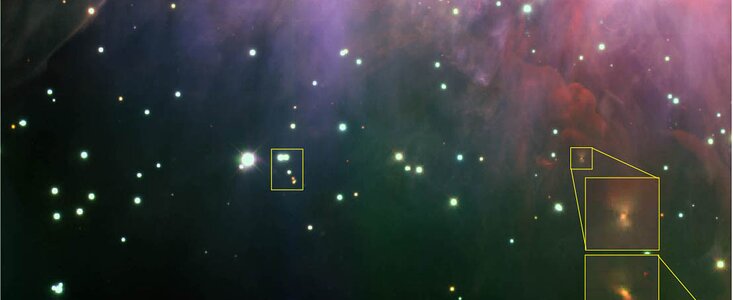Gemini Survey Uncovers Plethora of Trapezium Treasures
15 Junio 2005
It's Tough Being Small
(At Least in the Trapezium Region...)
The observed distribution of stars as a function of mass has a well-established behavior known as the initial mass function (IMF). For normal stars the IMF says that the quantity of more massive stars is lower than the number of less massive counterparts. In other words, smaller stars are more numerous than bigger ones. How does the IMF behave at lower masses, e.g. subsolar masses or for brown dwarfs, or even planetary size bodies? Stars in the Orion Trapezium region are bombarded by intense ultraviolet radiation. Does such a hostile environment influence the IMF? We do not yet know the answers to these questions.
To help provide answers, Gemini South Flamingos-I observations of the outer Trapezium region by Lucas et al. have probed the region to very faint levels in the infrared. These observations provide partial but very instructive clues. Lucas et al. find that of 396 objects in the survey region, only 138 are in the brown dwarf or planetary mass candidate category. They conclude that the IMF drops by a factor of two at the deuterium burning threshold (~0.012 Msun). Assuming an age of 1 million years, objects in the range of 3 to 13 MJup constitute only 1% to 10% of the total cluster population (see geminiann05006b).
The findings confirm that planetary mass objects are indeed rare in the outer parts of the Orion Nebula, a region known to be rich in low-mass stars due to mass segregation.
It is not clear whether Lucas et al. represents a typical IMF. Surveys of some other star-formation regions have reported larger numbers of planetary mass objects, but the amount of background contamination in these surveys is not yet known.
Using the Flamingos-I near-infrared imager at Gemini South, a UK/Japanese team of astronomers has imaged an outer region of the Trapezium Cluster near the center of the Orion Nebula, and identified 396 sources. Of these, 138 are brown dwarf candidates and 33 of those are candidate planetary mass objects. This could have an impact on our understanding of the initial mass function (IMF) for very low-mass bodies, especially in a hostile star forming environment (see sidebar at right).
The observations were made in J, H, and K bands (geminiann05006a) during observing runs in 2001 and 2002. Three fields were imaged for one hour each in K and H bands and two hours in J. The depth of these data allowed the identification of a variety of new low-mass objects, and led to comparisons with other independent surveys of adjacent regions, resulting in statistically significant conclusions.
The survey’s results are expected to provide a wealth of targets for future research in this star-forming region due to its depth and resolution. An ongoing study by the team is a spectroscopic follow-up with Gemini of the planetary mass objects (PMOs) of M < 13 MJup. Due to an increase in background contamination at this luminosity, the present study puts the upper limit of 3-13 MJup PMOs at 13% and likely at <10% of the cluster population (assuming an age of one million years for cluster members).
In addition to the identification of two new bipolar nebulae with bright central sources in the region, the study also found multiple trails and filaments that appear to be associated with low luminosity point sources. Others have no apparent point-source associations.
Another result of the survey analysis is that binary pairs of brown dwarfs and very low-mass stars (M<0.1Msun) are less likely than more massive stars to have wide separations (>150 AU) between them and any binary companions. When this is combined with an independent Subaru sample (of a different region in the Trapezium cluster), this relationship is confirmed to a 96% confidence level. Furthermore, a statistically very significant excess was found for both stars and brown dwarf pairs with small separations (< 6 arcseconds or 2,600 AU), which is consistent with the "ejected stellar embryo" hypothesis for brown dwarf formation. (See previous Gemini study of very low mass stars by Laird Close et al.)
For more details, see the article “A Deep Survey of Brown Dwarfs in Orion with Gemini,” by P.W. Lucas, P.F. Roche and M. Tamura in Monthly Notices of the Royal Astronomical Society, April 27, 2005.



